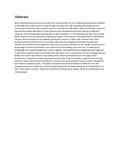| dc.contributor.author | Clare, Narrod | |
| dc.contributor.author | Devesh, Roy | |
| dc.contributor.author | Okello, Julius | |
| dc.contributor.author | Belem, Avendaño | |
| dc.contributor.author | Karl, Rich | |
| dc.date.accessioned | 2013-12-02T13:17:32Z | |
| dc.date.available | 2013-12-02T13:17:32Z | |
| dc.date.issued | 2007 | |
| dc.identifier.citation | Narrod, C., Roy, D., Okello, J., Avendaño, B., & Rich, K. (2007). The role of public-private partnerships and collective action in ensuring smallholder participation in high value fruit and vegetable supply chains (No. 70). International Food Policy Research Institute (IFPRI). | en |
| dc.identifier.uri | http://ideas.repec.org/p/fpr/worpps/70.html | |
| dc.identifier.uri | http://hdl.handle.net/11295/61447 | |
| dc.description.abstract | Many developing countries have moved into the production of non-traditional agricultural products to diversify their exports and increase foreign currency earnings. Accessing developed country markets and urban domestic markets requires meeting the food safety requirements due to several demand and supply side factors. Food retailers have developed protocols relating to pesticide residues, field and packinghouse operations, and traceability. In this changing scenario where food safety requirements are getting increasingly stringent, there are worries regarding the livelihood of the poor since companies that establish production centers in LDCs might exclude them. Poor producers face problems of how to produce safe food, be recognized as producing safe food, identify cost-effective technologies for reducing risk, and be competitive with larger producers with advantage of economies of scale in compliance with food safety requirements. In enabling the smallholders to remain competitive in such a system, new institutional arrangements are required. In particular, public-private partnerships can play a key role in creating farm to fork linkages that can satisfy the market demands for food safety while retaining smallholders in the supply chain. Furthermore, organized producer groups monitoring their own food safety requirements through collective action often become attractive to buyers who are looking for ways to ensure traceability and reduce transaction costs. This paper compares how small producers of different fruit and vegetable products in different countries have coped with increased demands for food safety from their main export markets. These commodities are Kenyan green beans, Mexican cantaloupes, and Indian grapes | en |
| dc.language.iso | en | en |
| dc.publisher | University of Nairobi | en |
| dc.relation.ispartofseries | ;No. 70 | |
| dc.title | The role of public-private partnerships and collective action in ensuring smallholder participation in high value fruit and vegetable supply chains | en |
| dc.type | Working Paper | en |
| local.publisher | Agricultural Economics | en |

